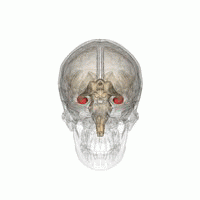the limbic system
The limbic system is a collection of highly specialized neural structures that sit at the top of the brain stem, which are involved in regulating our emotions. Collectively, the limbic system is a term that doesn’t have clearly defined areas as it includes multiple brain regions, but it is most commonly considered to be part of the forebrain. The limbic system is made up of a number of different structures, but a few of the most important are the thalamus, hippocampus, amygdala, and hypothalamus. These structures influence hunger, the sleep-wake cycle, sexual desire, fear, and aggression. The limbic system is also involved in processing both emotion and memory.
thalamus

The thalamus is a sensory relay station for the brain. It sits at the base of the forebrain, right above the midbrain, and is a paired structure with two halves in each hemisphere. All of our senses, with the exception of smell, are routed through the thalamus before being directed to other areas of the brain for processing (Figure 1). Interestingly, the sense of smell projects directly to the limbic system; therefore, not surprisingly, smell can evoke emotional responses in ways that other sensory modalities cannot. In addition to its role as a hub and station for sensory processing, the thalamus also plays a role in consciousness and arousal. Damage to the thalamus can lead to permanent coma, though comas are more typically associated with damage to the reticular activating system (RAS) in the brainstem.
hippocampus
The hippocampus is an essential structure for learning and memory. There are two sides of the hippocampus, located in each hemisphere, just above the ear within the temporal lobe. The hippocampus plays important roles in the consolidation of information from short-term memory to long-term memory and in spatial memory that enables navigation.

Clive Wearing, an accomplished musician, lost the ability to form new memories when his hippocampus was damaged through illness. Check out the first few minutes of this documentary video for an introduction to this man and his condition.
amygdala
The amygdala is involved in our experience of emotion and in tying emotional meaning to our memories. It consists of two almond-shape clusters in each hemisphere that have strong connections to reward systems in the brain, displays of aggression, the recognition of fear, and anxiety.

The Case of Henry Molaison (H.M.)
In 1953, Henry Gustav Molaison (H. M.) was a 27-year-old man who experienced severe seizures. In an attempt to control his seizures, H. M. underwent brain surgery to remove his hippocampus and amygdala. Following the surgery, H.M’s seizures became much less severe, but he also suffered some unexpected—and devastating—consequences of the surgery: he lost his ability to form many types of new memories. For example, he was unable to learn new facts, such as who was president of the United States. He was able to learn new skills, but afterward, he had no recollection of learning them. For example, while he might learn to use a computer, he would have no conscious memory of ever having used one. He could not remember new faces, and he was unable to remember events, even immediately after they occurred. Researchers were fascinated by his experience, and he is considered one of the most studied cases in medical and psychological history (Hardt, Einarsson, & Nader, 2010; Squire, 2009). Indeed, his case has provided tremendous insight into the role that the hippocampus plays in the consolidation of new learning into explicit memory.
The hypothalamus regulates a number of homeostatic processes, including the regulation of body temperature, appetite, and blood pressure. The hypothalamus also serves as an interface between the nervous system and the endocrine system and in the regulation of sexual motivation and behavior.
Remember: It’s Not That Simple
One important thing to keep in mind as you study the brain is that it is an oversimplification to say that certain parts are “responsible” for certain behaviors or actions. Consider the following advice from Joseph LeDoux, a professor of neuroscience and psychology at New York University, who emphasizes that the specific parts of the brain are really part of interconnected systems:
Be suspicious of any statement that says a brain area is a center responsible for some function. The notion of functions being products of brain areas or centers is left over from the days when most evidence about brain function was based on the effects of brain lesions localized to specific areas. Today, we think of functions as products of systems rather than of areas. Neurons in areas contribute because they are part of a system. The amygdala, for example, contributes to threat detection because it is part of a threat detection system. And just because the amygdala contributes to threat detection does not mean that threat detection is the only function to which it contributes. Amygdala neurons, for example, are also components of systems that process the significance of stimuli related to eating, drinking, sex, and addictive drugs.